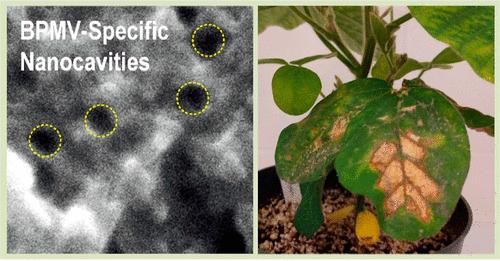Our official English website, www.x-mol.net, welcomes your
feedback! (Note: you will need to create a separate account there.)
Plant Virus Sensor for the Rapid Detection of Bean Pod Mottle Virus Using Virus-Specific Nanocavities
ACS Sensors ( IF 8.2 ) Pub Date : 2023-09-22 , DOI: 10.1021/acssensors.3c01478
Nawab Singh 1, 2 , Raufur Rahman Khan 1, 2 , Weihui Xu 3 , Steven A Whitham 3 , Liang Dong 1, 2
ACS Sensors ( IF 8.2 ) Pub Date : 2023-09-22 , DOI: 10.1021/acssensors.3c01478
Nawab Singh 1, 2 , Raufur Rahman Khan 1, 2 , Weihui Xu 3 , Steven A Whitham 3 , Liang Dong 1, 2
Affiliation

|
This study presents a miniaturized sensor for rapid, selective, and sensitive detection of bean pod mottle virus (BPMV) in soybean plants. The sensor employs molecularly imprinted polymer technology to generate BPMV-specific nanocavities in porous polypyrrole. Leveraging the porous structure, high surface reactivity, and electron transfer properties of polypyrrole, the sensor achieves a sensitivity of 143 μA ng–1 mL cm–2, a concentration range of 0.01–100,000 ng/mL, a detection time of less than 2 min, and a detection limit of 41 pg/mL. These capabilities outperform those of conventional methods, such as enzyme-linked immunosorbent assays and reverse transcription polymerase chain reactions. The sensor possesses the ability to distinguish BPMV-infected soybean plants from noninfected ones while rapidly quantifying virus levels. Moreover, it can reveal the spatial distribution of virus concentration across distinct leaves, a capability not previously attained by cost-effective sensors for such detailed viral data within a plant. The BPMV-specific nanocavities can also be easily restored and reactivated for multiple uses through a simple wash with acetic acid. While MIP-based sensors for plant virus detection have been relatively understudied, our findings demonstrate their potential as portable, on-site diagnostic tools that avoid complex and time-consuming sample preparation procedures. This advancement addresses a critical need in plant virology, enhancing the detection and management of plant viral diseases.
中文翻译:

利用病毒特异性纳米腔快速检测豆荚斑驳病毒的植物病毒传感器
本研究提出了一种微型传感器,用于快速、选择性和灵敏地检测大豆植物中的豆荚斑驳病毒 (BPMV)。该传感器采用分子印迹聚合物技术在多孔聚吡咯中生成 BPMV 特异性纳米腔。利用聚吡咯的多孔结构、高表面反应活性和电子传递特性,该传感器实现了143 μA ng –1 mL cm –2的灵敏度,浓度范围为0.01–100,000 ng/mL,检测时间小于2分钟,检测限为 41 pg/mL。这些功能优于传统方法,例如酶联免疫吸附测定和逆转录聚合酶链反应。该传感器能够区分受 BPMV 感染的大豆植物与未受感染的大豆植物,同时快速定量病毒水平。此外,它还可以揭示不同叶子上病毒浓度的空间分布,这是以前用于植物内如此详细的病毒数据的经济有效的传感器无法实现的能力。通过用乙酸进行简单的清洗,BPMV 特异性纳米腔也可以轻松恢复和重新激活以供多种用途。虽然用于植物病毒检测的基于 MIP 的传感器的研究相对较少,但我们的研究结果证明了它们作为便携式现场诊断工具的潜力,可以避免复杂且耗时的样品制备程序。这一进展满足了植物病毒学的迫切需求,增强了植物病毒病的检测和管理。
更新日期:2023-09-22
中文翻译:

利用病毒特异性纳米腔快速检测豆荚斑驳病毒的植物病毒传感器
本研究提出了一种微型传感器,用于快速、选择性和灵敏地检测大豆植物中的豆荚斑驳病毒 (BPMV)。该传感器采用分子印迹聚合物技术在多孔聚吡咯中生成 BPMV 特异性纳米腔。利用聚吡咯的多孔结构、高表面反应活性和电子传递特性,该传感器实现了143 μA ng –1 mL cm –2的灵敏度,浓度范围为0.01–100,000 ng/mL,检测时间小于2分钟,检测限为 41 pg/mL。这些功能优于传统方法,例如酶联免疫吸附测定和逆转录聚合酶链反应。该传感器能够区分受 BPMV 感染的大豆植物与未受感染的大豆植物,同时快速定量病毒水平。此外,它还可以揭示不同叶子上病毒浓度的空间分布,这是以前用于植物内如此详细的病毒数据的经济有效的传感器无法实现的能力。通过用乙酸进行简单的清洗,BPMV 特异性纳米腔也可以轻松恢复和重新激活以供多种用途。虽然用于植物病毒检测的基于 MIP 的传感器的研究相对较少,但我们的研究结果证明了它们作为便携式现场诊断工具的潜力,可以避免复杂且耗时的样品制备程序。这一进展满足了植物病毒学的迫切需求,增强了植物病毒病的检测和管理。







































 京公网安备 11010802027423号
京公网安备 11010802027423号